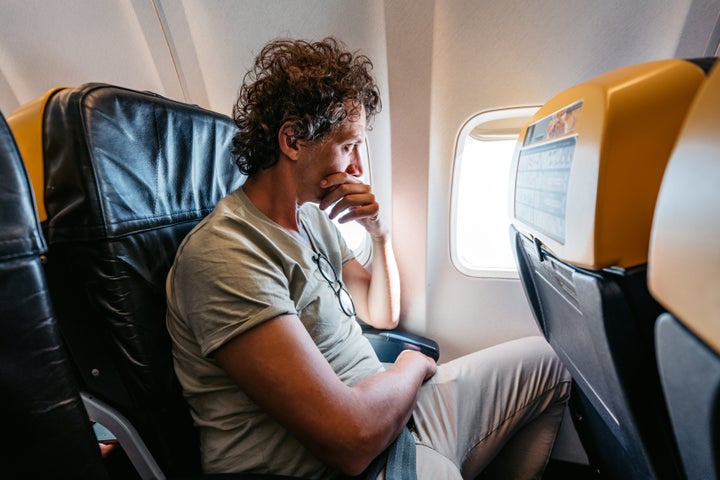
Claustrophobia. Germophobia. Agoraphobia. You’ve likely heard of these extreme fears that can impact a person’s ability to go about their day-to-day life.
A lesser-known phobia is hodophobia ― a fear of travel ― but it can similarly interfere with the way someone views and interacts with the world.
How exactly does hodophobia manifest and how do those afflicted deal with it? Below, experts break down the symptoms, causes and coping mechanisms.
What is hodophobia?
“Hodophobia is an irrational and often paralysing fear of travelling,” Dr. Neha Pathak, WebMD’s chief physician editor of health and lifestyle medicine, told HuffPost. “Like other phobias, it’s usually specific to the individual with regard to how it shows up in their lives and how severely it affects them.”
Someone with hodophobia might be afraid of various modes of transportation or simply fear spending any time away from their home.
“It can also be mixed with other disorders like claustrophobia or social anxiety, but hodophobia can also simply exist without other additional overlapping fears,” Pathak added. “The common thread with phobias is fear or anxiety is out of proportion to the actual danger posed by the specific situation — and for many people there are associated physical symptoms like shaking, nausea, sweating, fast heartbeat.”
Someone with this condition might experience extreme anxiety or depression ahead of a trip. Headaches, chest pain, dizziness and gastrointestinal symptoms might also occur.
“Someone with the condition may seem perfectly confident and functional with normal, day-to-day activities, but suffer debilitating fear with the thought of travel by the mode that causes their phobia,” Pathak said.
In severe cases, they might even have full-blown panic attacks at the thought of traveling and therefore avoid thinking about it — much less doing it. This phobia can interfere with work, family obligations and personal pleasure, as it may hinder one’s ability to participate in travel plans they actually want to carry out.
“Hodophobia causes the affected person clinically significant emotional distress or disrupts their life in some way,” emphasised psychologist Michele Leno. “It is not reserved for those who simply do not care about traveling.”
What causes it?
“Hodophobia can result from different types of experiences or exposures,” Pathak said. “It may be that an individual experienced a traumatic event while traveling themselves or heard of a major world event — like a deadly plane crash — and developed the fear based on hearing about the tragedy. Often, traumatising travel experiences in childhood can leave a lasting imprint that can play a role in developing the phobia later in life.”
Basically, the person made some connection between travel and a negative experience. Leno noted that thoughts of something traumatic occurring while a person is away from home might drive their fear.
“Perhaps they had a bad experience during or immediately after a vacation several years ago; now ‘travel = bad’ is stored in their brain,” she explained.
Although a prior tragedy or traumatic event might be at the root of one’s hodophobia, irrational thinking helps maintain it.
“A person with phobias thinks in extremes such as ‘always’ and ‘never,’” Leno said. “One bad experience may lead them to believe that travel caused the problem and something bad will happen every time they travel. Others may quickly notice the irrational mindset, but pointing it out will not do much good. People with phobias feel distressed enough and eventually realise they are being irrational. But it takes more than insight to overcome such an issue.”
How is it treated?
“Similar to treating and managing other phobias, talking with a therapist or working with a mental health professional is key to managing the condition,” Pathak said.
Psychologists might try exposure therapy, cognitive therapy, group therapy or a combination or approaches.
“As with any phobia, the goal of treatment is desensitisation,” Leno said. “The therapist and client work together to gradually overcome the fear of traveling. For instance, the therapist may encourage the client who desires to travel abroad to have an overnight stay at a hotel or Airbnb about an hour away from home. The next step may involve a weekend trip two hours from home.”
She noted that a doctor might prescribe medication for hodophobia, but that taking medicine alone might not be enough to overcome the powerful thoughts that nurture phobias.
“Through cognitive therapy, a person can begin to recognise their irrational or phobic thoughts that influence behaviour,” Leno explained. “How we think affects how we feel. The therapist and client explore rational and irrational thoughts connected to the fears. A person may fear taking longer to return home because of a delayed flight, and this is rational.”
Visualising what a successful journey could look like might help some people gain a feeling of control over the travel experience and thus minimise their sense of fear. Pathak recommended taking steps in advance of your trip if you struggle with hodophobia.
“It may be helpful to plan out each leg of the journey, from how you are going to get from your home to the airport, to the gate, your seat on the plane, the luggage carousel on your way to your destination, etc.” Pathak said. “The more you plan ahead, the more control you may feel over the experience and your emotions.”
She also recommended giving yourself plenty of time to get where you need to be in order to avoid additional anxiety or fear around arriving late. Expect possible delays.
“Sleep well and eat healthy snacks so you are operating on a full night’s rest and a full stomach,” Pathak added. “Start out by traveling with someone you trust.”